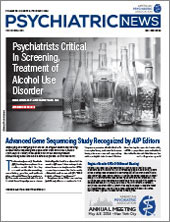What is the U.S. military’s best kept secret? If you ask Army psychiatrist Keith Penska, M.D., it’s at the Alexander T. Augusta Military Medical Center, located right outside Washington, D.C. It’s at this center that one can find the
Department of Defense’s only adolescent inpatient behavioral health unit. At the annual meeting of the American Academy of Child and Adolescent Psychiatry, Penska and colleagues discussed the unit, which opened in 2017.
Much of military health services focuses on “getting soldiers back to combat readiness as soon as possible,” explained Keith Denneny, N.P., D.N.P., who oversees the nursing staff at the unit. Part of that readiness includes soldiers knowing that their families have the support they need to maintain good health. (The military community includes about 1.6 million family members of active-duty personnel.)
That was one of the lines of argument Penska made during his pitch to hospital administrators for an inpatient psychiatric unit for youth several years back. At the time, the Alexander T. Augusta Military Medical Center already offered outpatient psychiatric care for children, including a four-week intensive outpatient program (where adolescents spend several hours each day at the medical center but go home each afternoon).
“With an inpatient unit, we could click on all cylinders,” he said, noting that clinicians could seamlessly adjust the intensity of behavioral health care for adolescent patients without transferring them off site.
Penska also made the case for the educational opportunities that an inpatient unit could offer to medical residents in pediatrics and other specialties. And it helped that there was move-in ready space at the hospital, as the inpatient substance use disorder (SUD) unit had recently moved to a different floor.
The lobbying efforts worked, and on February 10, 2017, the medical center opened its
Adolescent Inpatient Behavioral Health Unit. The unit started with six beds, though it ramped up to 11 beds and a team of 42, including two psychiatrists and a team of educators, social workers, therapists, nurses, and behavioral health technicians. Following the COVID-19 pandemic, the number of beds dropped to eight due to staffing shortages.
The unit serves youth aged 12 to 18 (18-year-olds must still be in high school) and treats youth presenting with most psychiatric issues, with the exception of severe eating disorders and primary substance use disorders.
In addition to treating patients via medications, psychotherapy, and family therapy, the staff help the adolescents stay up to date with their schoolwork and offer a range of recreational activities.
“With our patients, downtime is danger time,” Penska said. “We have art therapy, we bring in animals that they play with, we have visits from the chaplin, and more; we are always looking for fresh ideas.”
Penska said that admissions have risen continually since the opening of the center, rising from 155 patients in 2018 (its first full year) to 189 in 2022. The most common reasons for admission include psychosis, depression accompanied by suicidal ideation, and severe adjustment disorders, he said.
Any child of an active-duty servicemember or retiree is eligible for services at the inpatient center, though patients primarily arrive from the surrounding Washington metropolitan region. Penska said the unit has on occasion treated youth transferred from locations abroad.
For instance, he noted, “Guam doesn’t have a single inpatient psychiatric facility on the whole island.” In these situations, the family typically cannot go back as their home location does not have adequate psychiatry facilities for the youth. “The family has to accept a reassignment, which can lead to some difficult conversations.”
The average length of stay for youth seen at Fort Belvoir’s Adolescent Inpatient Behavioral Health Service unit is about 12 days, Penska said, which he noted is longer than at civilian inpatient units.
Before youth are discharged from the hospital, they are required to have a confirmed follow-up appointment with their primary care physician and an established aftercare plan (for example, securing a spot in an intensive outpatient program or residential treatment facility).
Penska noted that 30-day readmission rates for patients seen in the unit have been consistently about 4% to 5% across the first five years, which is lower than national averages for youth.
“It could be partially due to the military population being slightly healthier on average and that all our patients have established health care,” he said. “But I think the longer stays and focus on aftercare contribute significantly.” ■

